Electric System Reliability Annual Reports
Overview
CPUC Decision D.16-01-008 directs the California Investor Owned Utilities (PG&E, SCE, SDG&E, Bear Valley Electric Service, PacifiCorp, and Liberty Utilities/CalPeco Electric) to annually prepare electric system reliability reports detailing the previous year’s electric reliability on the system and division levels. Appendix B of the Decision provides a template for the utilities to share this data. These reports are submitted to Energy Division annually on July 15th. Reports dating back to 1997 are linked to the right. Note that the previous governing decision, D.96-09-045, was the reporting standard from 1996 until it was superseded by D.16-01-008 in 2016.
Here, reliability reporting refers to recorded average outage duration and frequency. This is separate and distinct from reliability as it pertains to Resource Adequacy, which is concerned with resource procurement and infrastructure investment to ensure electric demand is met at the California Independent System Operator (CAISO) level. Details about the CPUC’s resource adequacy program can be found here.
Definitions
Electric System Reliability Metrics are defined by the Institute of Electrical and Electronics Engineers in standard IEEE 1366 – Guide for Electric Power Distribution Reliability Indices. The Commission requires the utilities to report on the following four metrics annually:
- System Average Interruption Duration Index (SAIDI)
- Measures the average total minutes of outage that a customer on the system experienced in the reporting year.
- Measures the average total minutes of outage that a customer on the system experienced in the reporting year.
- System Average Interruption Frequency Index (SAIFI)
- Measures the average number of sustained outages (i.e., outages greater than 5 minutes in length) that a customer on the system experienced in the reporting year.
- Measures the average number of sustained outages (i.e., outages greater than 5 minutes in length) that a customer on the system experienced in the reporting year.
- Customer Average Interruption Duration Index (CAIDI)
- Measures the average duration of a single sustained outage (i.e., an outage that lasted for longer than 5 minutes) that a customer experienced in the reporting year.
- Measures the average duration of a single sustained outage (i.e., an outage that lasted for longer than 5 minutes) that a customer experienced in the reporting year.
- Momentary Average Interruption Duration Index (MAIFI)
- Measures the average number of momentary outages (i.e., outages that lasted less than 5 minutes) that a customer experienced in the reporting year.
These metrics are required to be reported with and without the inclusion of Major Event Days (MEDs). MEDs are defined by IEEE 1366 as days in which the daily SAIDI of an event exceeds a statistically defined threshold based on the previous 5 years of daily SAIDI data. This threshold excludes all but the worst 0.63% of outage events, making MEDs low frequency, high consequence events. The cause of an outage has no bearing on whether it will be classified as an MED.
Public Safety Power Shutoff (PSPS) events are considered MEDs only insofar as they exceed this statistically defined threshold. For more information about PSPS, please visit the CPUC’s De-Energization webpage here: https://www.cpuc.ca.gov/psps/.
The February 17th, 2021, Commissioner Committee Meeting on Emerging Trends contained a presentation explaining the reliability metrics and how they are used. The video can be accessed here; the presentation runs for the first 45 minutes of the video including questions from Commissioners. The presentation slides from that meeting can be accessed here.
California Utilities’ Reliability Performance
The following charts show the California utilities’ 2020 reliability performance as compared to the national average and the Southwest states’ average. For this comparison, the average for the Southwest states includes data from utilities in Arizona, California, Colorado, New Mexico, Nevada, and Utah. These averages are aggregated from the US Energy Information Administration’s Annual Electric Power Industry Report. Reports dating back to 1990 can be found here: https://www.eia.gov/electricity/data/eia861/.
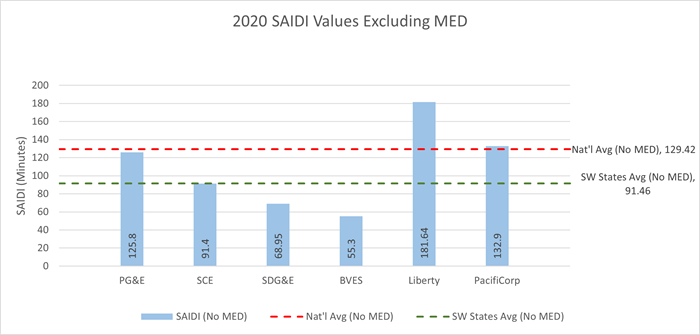
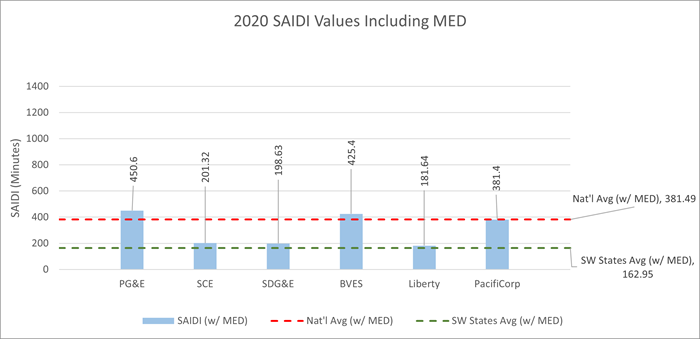
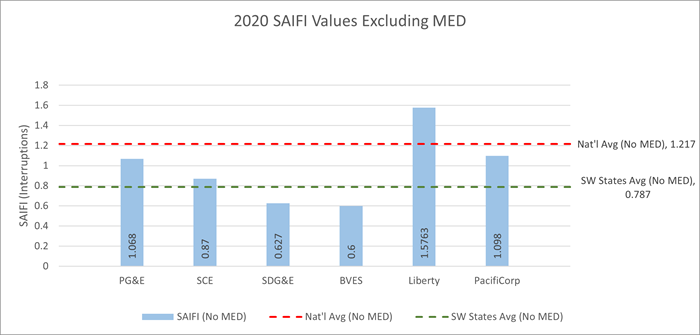
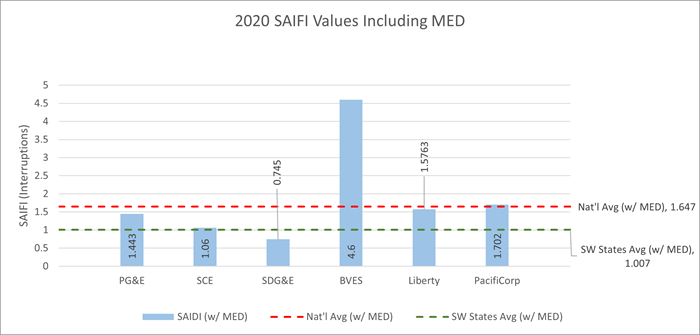
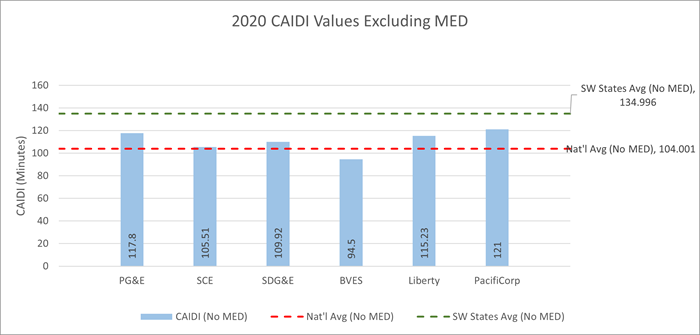
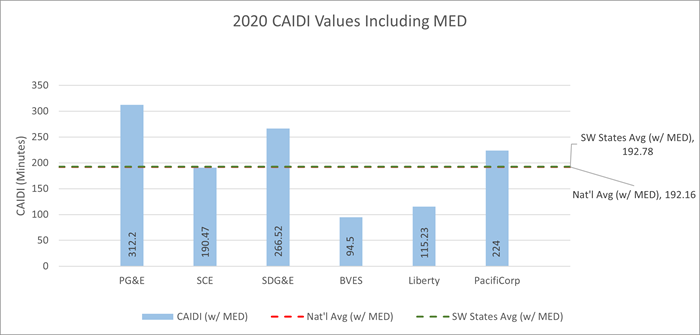
Reliability Data Requests:
In D.16-01-008, the CPUC required each of the six respondent utilities to make reliability data available to the public upon request. Below are details about how reliability data can be requested from each utility as well as required timelines and other details:
- PG&E:
- Call 1-800-743-5000.
- This is PG&E’s general number, but requests about outage history will trigger the creation of an Electric Service Reliability ticket which is then assigned to an engineer of the appropriate local office who will perform follow ups and research.
- For businesses or government agencies, PG&E also processes reliability data requests through its business account representatives and local public affairs representatives.
- PG&E is required to respond to customer inquiries within 15 days.
- SCE:
- Email CircuitReliability@sce.com
- Individual and business customers can use this inbox to ask questions or to obtain specific reliability data.
- Local and tribal governments can contact their SCE local public affairs representative to obtain more information on their jurisdictions.
- SCE is required to respond to customer inquiries within 15 days.
- SDG&E:
- Call 1-800-411-7343 or submit a Reliability Request form here.
- Individual or business customers can request an Electric Reliability Outage History Report through this process.
- Local and tribal government customers can contact their local Regional Public Affairs manager or account executive to request data for their jurisdictions.
- SDG&E is required to respond to customer inquiries within 15 days.
- Bear Valley Electric Service:
- Call (800) 808-BVES.
- BVES is required to respond to customer inquiries within 30 days.
- Liberty Utilities:
- Call 1-800-782-2506.
- Email powerquality@libertyutilities.com.
- Liberty is required to respond to customer inquiries within 30 days.
- PacifiCorp:
- Call 1-888-221-7070.
- Complete the contact form here: https://csapps.pacificpower.net/public/about/contact-us.
- PacifiCorp is required to respond to customer inquiries within 30 days.
Utility Reliability Websites and Current Outage Maps:
Further information about the utilities’ electric system reliability and current outages can be found here:
- PG&E:
- SCE:
- Reliability Reports: https://www.sce.com/outage-center/reliability-reports
- Outage Map: https://www.sce.com/outage-center/check-outage-status
- SDG&E:
- Reliability Reports: https://www.sdge.com/system-reliability
- Outage Map: https://www.sdge.com/residential/customer-service/outage-center/outage-map
- BVES:
- Reliability Reports: https://www.bvesinc.com/safety/reliability/
- Outage Reports: https://www.bvesinc.com/outages/
- Liberty:
- Reliability Reports/Outage Map: https://california.libertyutilities.com/north-lake-tahoe/residential/emergencies/electrical/outages-map.html
- PacifiCorp:
- Reliability Reports: https://www.pacificpower.net/outages-safety/reliability.html
- Outage Map: https://www.pacificpower.net/outages-safety.html
Electric System Reliability Annual Reports
2024 Annual Electric Reliability Report
2023 Annual Electric Reliability Report
2022 Annual Electric Reliability Report
2021 Annual Electric Reliability Report
2020 Annual Electric Reliability Report
2019 Annual Electric Reliability Report
2018 Annual Electric Reliability Report
2017 Annual Electric Reliability Report
2016 Annual Electric Reliability Report
2015 Annual Electric Reliability Report
2014 Annual Electric Reliability Report
2013-Annual-Electric-Reliability-Report
2012 Annual Electric Reliability Report
2011 Annual Electric Reliability Report
2010 Annual Electric Reliability Report
2009 Annual Electric Reliability
2008 Annual Electric Reliability Report
2007-Annual-Electric-Reliability-Report
2006-Annual-Electric-Reliability-Report
2004-2005 Annual Electric Reliability Report
2003-2002-Annual-Electric-Reliability-Report
